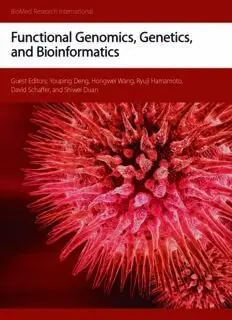Table Of ContentBioMed Research International
Functional Genomics, Genetics,
and Bioinformatics
Guest Editors: Youping Deng, Hongwei Wang, Ryuji Hamamoto,
David Schaffer, and Shiwei Duan
Functional Genomics, Genetics,
and Bioinformatics
BioMed Research International
Functional Genomics, Genetics,
and Bioinformatics
GuestEditors:oupingDeng,HongweiWang,RyujiHamamoto,
David Schaffer, and Shiwei Duan
Copyright©2015HindawiPublishingCorporation.Allrightsreserved.
Thisisaspecialissuepublishedin“BioMedResearchInternational.”AllarticlesareopenaccessarticlesdistributedundertheCreative
CommonsAttributionLicense,whichpermitsunrestricteduse,distribution,andreproductioninanymedium,providedtheoriginal
workisproperlycited.
Contents
FunctionalGenomics,Genetics,andBioinformatics,YoupingDeng,HongweiWang,RyujiHamamoto,
DavidSchaffer,andShiweiDuan
Volume2015,ArticleID184824,3pages
EvolutionaryPatternandRegulationAnalysistoSupportWhyDiversityFunctionsExistedwithin
PPARGeneFamilyMembers,TianyuZhou,XipingYan,GuosongWang,HeheLiu,XiangGan,TaoZhang,
JiwenWang,andLiangLi
Volume2015,ArticleID613910,11pages
ThePlantGrowth-PromotingBacteriaAzospirillumamazonense:GenomicVersatilityand
PhytohormonePathway,RicardoCecagno,TiagoEbertFritsch,andIreneSilveiraSchrank
Volume2015,ArticleID898592,7pages
ShapedSingularSpectrumAnalysisforQuantifyingGeneExpression,withApplicationtotheEarly
DrosophilaEmbryo,AlexShlemov,NinaGolyandina,DavidHolloway,andAlexanderSpirov
Volume2015,ArticleID689745,14pages
EffectofCelastrolonGrowthInhibitionofProstateCancerCellsthroughtheRegulationofhERG
ChannelInVitro,NanJi,JinjunLi,ZexiongWei,FanhuKong,HongyanJin,XiaoyaChen,YanLi,
andYoupingDeng
Volume2015,ArticleID308475,7pages
TheExpressionandDistributionsofANP32AintheDevelopingBrain,ShanshanWang,YunliangWang,
QingshanLu,XinshanLiu,FuyuWang,XiaodongMa,ChunpingCui,ChengheShi,JinfengLi,
andDajinZhang
Volume2015,ArticleID207347,8pages
ProtectingIntestinalEpithelialCellNumber6againstFissionNeutronIrradiationthroughNF-𝜅B
SignalingPathway,Gong-MinChang,Ya-BingGao,Shui-MingWang,Xin-PingXu,LiZhao,JingZhang,
Jin-FengLi,Yun-LiangWang,andRui-YunPeng
Volume2015,ArticleID124721,8pages
HumanUmbilicalCordMesenchymalStemCellsInfectedwithAdenovirusExpressingHGFPromote
RegenerationofDamagedNeuronCellsinaParkinson’sDiseaseModel,Xin-ShanLiu,Jin-FengLi,
Shan-ShanWang,Yu-TongWang,Yu-ZhenZhang,Hong-LeiYin,ShuangGeng,Hui-CuiGong,BingHan,
andYun-LiangWang
Volume2014,ArticleID909657,7pages
RelationshipbetweenCCRandNT-proBNPinChineseHFPatients,andTheirCorrelationswith
SeverityofHF,ZhigangLu,BoWang,YunliangWang,XueqingQian,WeiZheng,andMengWei
Volume2014,ArticleID106252,7pages
CharacterizationofPutativecis-RegulatoryElementsinGenesPreferentiallyExpressedinArabidopsis
MaleMeiocytes,JunhuaLi,JinhongYuan,andMingjunLi
Volume2014,ArticleID708364,10pages
AGenome-WideIdentificationofGenesUndergoingRecombinationandPositiveSelectionin
Neisseria,DongYu,YuanJin,ZhiqiuYin,HongguangRen,WeiZhou,LongLiang,andJunjieYue
Volume2014,ArticleID815672,9pages
NovelApproachforCoexpressionAnalysisofE2F13andMYCTargetGenesinChronicMyelogenous
Leukemia,FengfengWang,LawrenceW.C.Chan,WilliamC.S.Cho,PetrusTang,JunYu,Chi-RenShyu,
NancyB.Y.Tsui,S.C.CesarWong,ParcoM.Siu,S.P.Yip,andBenjaminY.M.Yung
Volume2014,ArticleID439840,7pages
TheEffectsoftheContext-DependentCodonUsageBiasontheStructureofthensp1𝛼ofPorcine
ReproductiveandRespiratorySyndromeVirus,Yao-zhongDing,Ya-nanYou,Dong-jieSun,
Hao-taiChen,Yong-luWang,Hui-yunChang,LiPan,Yu-zhenFang,Zhong-wangZhang,PengZhou,
Jian-liangLv,Xin-shengLiu,Jun-junShao,Fu-rongZhao,TongLin,LaszloStipkovits,ZygmuntPejsak,
Yong-guangZhang,andJieZhang
Volume2014,ArticleID765320,10pages
CellType-DependentRNARecombinationFrequencyintheJapaneseEncephalitisVirus,
Wei-WeiChiang,Ching-KaiChuang,MeiChao,andWei-JuneChen
Volume2014,ArticleID471323,9pages
ComputationalEvidenceofNAGNAGAlternativeSplicinginHumanLargeIntergenicNoncoding
RNA,XiaoyongSun,SimonM.Lin,andXiaoyanYan
Volume2014,ArticleID736798,7pages
iCTX-Type:ASequence-BasedPredictorforIdentifyingtheTypesofConotoxinsinTargetingIon
Channels,HuiDing,En-ZeDeng,Lu-FengYuan,LiLiu,HaoLin,WeiChen,andKuo-ChenChou
Volume2014,ArticleID286419,10pages
AnAssociationStudybetweenGeneticPolymorphismintheInterleukin-6ReceptorGeneand
CoronaryHeartDisease,JiangqingZhou,XiaoliangChen,HuadanYe,PingPeng,YannaBa,XiYang,
XiaoyanHuang,YaeLu,XinJiang,JiangfangLian,andShiweiDuan
Volume2014,ArticleID504727,6pages
Meta-AnalysisofLowDensityLipoproteinReceptor(LDLR)rs2228671PolymorphismandCoronary
HeartDisease,HuadanYe,QianleiZhao,YiHuang,LingyanWang,HaiboLiu,ChunmingWang,
DongjunDai,LeitingXu,MengYe,andShiweiDuan
Volume2014,ArticleID564940,6pages
UsingtheSadakaneCompressedSuffixTreetoSolvetheAll-PairsSuffix-PrefixProblem,
MaanHajRachid,QutaibahMalluhi,andMohamedAbouelhoda
Volume2014,ArticleID745298,11pages
Associationbetween𝜀2/3/4,PromoterPolymorphism(−491A/T,−427T/C,and−219T/G)atthe
ApolipoproteinEGene,andMentalRetardationinChildrenfromanIodineDeficiencyArea,China,
JunLi,FuchangZhang,YunliangWang,YanWang,WeiQin,QingheXing,XueqingQian,TingweiGuo,
XiaocaiGao,LinHe,andJianjunGao
Volume2014,ArticleID236702,6pages
Hindawi Publishing Corporation
BioMed Research International
Volume 2015, Article ID 184824, 3 pages
http://dx.doi.org/10.1155/2015/184824
Editorial
Functional Genomics, Genetics, and Bioinformatics
YoupingDeng,1HongweiWang,2RyujiHamamoto,2DavidSchaffer,3andShiweiDuan4
1DepartmentofInternalMedicine,RushUniversityCancerCenter,RushUniversityMedicalCenter,Chicago,IL60612,USA
2DepartmentofMedicine,UniversityofChicago,Chicago,IL60637,USA
3DepartmentofBioengineering,BinghamtonUniversity,Binghamton,NY13902,USA
4SchoolofMedicine,NingboUniversity,Ningbo,Zhejiang315211,China
CorrespondenceshouldbeaddressedtoYoupingDeng;youping deng@rush.edu
Received10December2014;Accepted10December2014
Copyright©2015YoupingDengetal.ThisisanopenaccessarticledistributedundertheCreativeCommonsAttributionLicense,
whichpermitsunrestricteduse,distribution,andreproductioninanymedium,providedtheoriginalworkisproperlycited.
Biologyhasbecomethelandofthe“-omics,”includinggeno- Bioinformatics.Inthebioinformaticspapers,fourpapersdeal
mics[1],transcriptomics[2,3],epigenomics[4],proteomics with transcriptomics data. F. Wang et al. developed a novel
[5], lipidomics [6, 7], and metabolomics [8]. Each of these approachforcoexpressionanalysisofE2F1-3andMYCtarget
“-omics”generatesahugeamountofhigh-throughputdata, genesinchronicmyelogenousleukemia(CML);theyfound
anditisachallengebothtoanalyzethesedataandtofurther asignificantdifferenceinthecoexpressionpatternsofthose
investigatethefunctionofspecificmolecules.Thoughmore candidate target genes between the normal and the CML
genomeshavebeencompletedduetotherapiddevelopment groups. It is challenging to analyze the quantity of image
ofsequencingtechnology[9],wecannotunderstandtheinfo- data on gene expression. A. Shlemov et al. developed a
rmation contained within a genome until we mine out its method called 2D singular spectrum analysis (2D-SSA) for
implicated functions including downstream transcription, applicationto2Dand3Ddatasetsofembryoimagesrelated
translation,epigeneticsmodulation,andmetabolicpathways. to gene expression; it turned out to work pretty well. J. Li
Inthisspecialissue,wemainlyfocusonfunctional“-omics” et al. characterized putative cis-regulatory elements (CREs)
andbioinformatics. associatedwithmalemeiocyte-expressedgenesusinginsilico
The Peer-reviewed papers are collected in the special tools.Theyfoundthattheupstreamregions(1kb)ofthetop
issue.Theyareapproximatelydividedintothreeareas:bioin- 50 genes preferentially expressed in Arabidopsis meiocytes
formatics,functionalgenomics,andfunctionalgenetics.The possessed conserved motifs, which were potential binding
majority of the papers are purely bioinformatics related sites of transcription factors. NAGNAG alternative splicing
papers.Wedefinebioinformaticspapersasthoseusingcom- playsanimportantroleinbiologicalprocessesandrepresents
putationaltoolsordevelopingmethodstoanalyzefunctional ahighlyadaptablesystemforposttranslationalregulationof
“-omics”datawithoutusingwetlabs.Twopapersfellintothe genefunction.Interestingly,X.Sunetal.identifiedabout31
categoryoffunctionalgen-omics,whichisfocusedonusing NAGNAG alternative splicing sites that were identified in
whole genome level wet-lab technology to find important humanlargeintergenicnoncodingRNAs(lincRNAs).
molecules and investigate their potential functions. Five Threepapersarefocusedonthedeificationofnewgene
papers are considered as functional genetics papers. Func- family members and gene evolution. Conotoxins are small
tionalgeneticsisabroadconcepthereandthesepapersare disulfide-rich neurotoxic peptides, which can bind to ion
concentratedonstudyingthemolecularfunctionsandmech- channelswithveryhighspecificityandregulatetheiractiv-
anisms of individual molecules using wet-lab experimental ities.H.Dingetal.developedanovelmethodcallediCTX-
approaches. Type,whichisasequence-basedpredictorthatcanbeusedto
2 BioMedResearchInternational
identifythetypesofconotoxinsintargetingionchannels.A couldpromotetheregenerationofdamagedParkinson’sdis-
user-friendlywebtoolisalsoavailable.Y.-Z.Zhouetal.ana- ease(PD)cellsathigherefficacythanthesupernatantfrom
lyzed the evolution pattern and function diversity of PPAR hUC-MSCsalone.Thus,thecombinationofhUC-MSCwith
gene family members based on 63 homology sequences of HGF could potentially be a new biological treatment for
PPARgenesfrom31species.Theyfoundthatgeneduplication PD. One paper is focused on cancer. N. Ji et al. found that
events,selectionpressuresonHOLIdomain,andthevariants celastrolhadantiprostatecancereffectspartiallythroughthe
on promoter and 3UTR are critical for PPARs evolution downregulation of the expression level of hERG channel in
and acquiring diversity functions. There has recently been DU145cells,suggestingthatcelastrolmaybeapotentialagent
considerable focus on its two human pathogenic species N. against prostate cancer with a mechanism of blocking the
meningitidisandN.gonorrhoeae,whichbelongtoNeisseria,a hERG channel. One paper is studying heart disease. Z. Lu
genusofgram-negativebacteria.D.Yuetal.selected18Neis- etal.reportedthatthelevelsofNT-proBNPandCCRwere
seria genomes, preformed a comparative genome analysis, closelyrelatedtotheoccurrenceofHFandwereindependent
and identified 635 genes with recombination signals and 10 risk factors for heart failure (HF). Meanwhile, there was a
genesthatshowedsignificantevidenceofpositiveselection. significant negative correlation between the levels of NT-
Furtherfunctionalanalysesrevealedthatnofunctionalbias proBNPandCCR.Oneinterestingpaperistryingtounder-
was found in the recombined genes. The data help us to standthefunctionofJapaneseencephalitisvirus(JEV),and
understandtheadaptiveevolutioninNeisseria. they have demonstrated that RNA recombination in JEV
One paper tried to solve the key algorithm issue called occurs unequally in different cell types. They conclude that
theall-pairssuffix-prefixmatchingproblem,whichiscrucial theadjustmentofviralRNAtoanappropriatelylowerlevelin
fordenovogenomeassembly.M.H.Rachidetal.developed mosquitocellspreventsovergrowthofthevirusandisbenefi-
a space-economical solution to the problem using the gen- cialforcellstosurvivetheinfection.
eralized Sadakane compressed suffix tree. One paper con- Insummary,thisspecialissuepresentsabroadrangeof
ducted a comparative genomics analysis. R. Cecagno et al. topicsfromfunctionalgenomics,genetics,andbioinformat-
found that the versatile gene repertoire in the genome of ics.Itcoversavarietyofdiseasessuchascancer,heart,and
rhizospherebacteriumAzospirillumamazonensecouldhave neuralandinfectiousdiseases.Thestudyorganismsinclude
beenacquiredfromdistantlyrelatedbacteriafromhorizontal human,mouse,plant,andmicroorganisms.Wehopethatthe
transfer. They also demonstrated that the coding sequence readers will find interesting knowledge and methods in the
related to production of phytohormones, such as flavin issue.
monooxygenaseandaldehydeoxidase,islikelytorepresent
thetryptophan-dependentTAMpathwayforauxinproduc- YoupingDeng
tion in this bacterium. They conclude that the genomic HongweiWang
structureofthebacteriahasevolvedtomeettherequirement RyujiHamamoto
for adaptation to the rhizosphere and interaction with host DavidSchaffer
plants. ShiweiDuan
Onearticleconductedameta-analysis.H.Yeetal.have
demonstratedthatrs2228671isaprotectivefactorofCHDin
References
Europeans.Onepaperisconcentratedonthemicroorganism
bioinformatics.Y.Dingetal.recognizedtherolesofthesyn-
onymouscodonusageintheformationofnsp1𝛼structureof [1] M. Jia, Y. Liu, Z. Shen et al., “HDAM: a resource of human
diseaseassociatedmutationsfromnextgenerationsequencing
porcinereproductiveandrespiratorysyndromevirusPRRSV.
studies,”BMCMedicalGenomics,vol.6,supplement1,article
S16,2013.
Functional Genomics. There are two papers that conducted
[2] Y.Deng,S.A.Meyer,X.Guanetal.,“Analysisofcommonand
geneassociationstudiesbasedongenomewidedata.J.Liet
al.foundthatthepresenceofATT𝜀4haplotypewasassociated specificmechanismsofliverfunctionaffectedbynitrotoluene
compounds,”PLoSONE,vol.6,no.2,ArticleIDe14662,2011.
withanincreasedriskofmentalretardation(MR)inchildren
but did not find any significant association between single [3] H.Jiang,Y.Deng,H.-S.Chenetal.,“Jointanalysisoftwomicr-
loci of the four common ApoE polymorphisms (−491A/T, oarraygene-expressiondatasetstoselectlungadenocarcinoma
−427T/C,−219T/G,and𝜀2/3/4)andMRorborderlineMR. markergenes,”BMCBioinformatics,vol.5,article81,2004.
J.Zhouetal.didnotfindanassociationbetweenrs7529229 [4] J.Melson,Y.Li,E.Cassinottietal.,“Commonalityanddiffer-
andchronicheartdisease(CHD)inHanChinese.However, encesofmethylationsignaturesintheplasmaofpatientswith
theirmeta-analysesindicatedthatrs7529229wasassociated pancreaticcancerandcolorectalcancer,”InternationalJournal
withtheCHDriskinEuropeans. ofCancer,vol.134,no.11,pp.2656–2662,2014.
[5] F.Xu,G.Li,C.Zhaoetal.,“Globalproteininteractomeexplo-
Functional Genetics. There are 5 articles that investigate the rationthroughmininggenome-scaledatainArabidopsistha-
individual gene function in different areas. Two papers are liana,”BMCGenomics,vol.11,articleS2,supplement2,2010.
related to neural diseases. G.-M. Chang et al. found that
[6] Y. Wang, C. Zhao, J. Mao et al., “Integrated lipidomics and
activating NF-𝜅B signaling pathway can protect intestinal transcriptomicanalysisofperipheralbloodrevealssignificantly
epithelialcellNo.6againstfissionneutronirradiation.X.-S. enrichedpathwaysintype2diabetesmellitus,”BMCMedical
Liuetal.demonstratedthathepatocytegrowthfactor(HGF) Genomics,vol.6,no.1,articleS12,2013.
BioMedResearchInternational 3
[7] X. Zhou, J. Mao, J. Ai et al., “Identification of plasma lipid
biomarkersforprostatecancerbylipidomicsandbioinformat-
ics,”PLoSONE,vol.7,no.11,ArticleIDe48889,2012.
[8] T.W.-M.Fan,A.N.Lane,andR.M.Higashi,“Thepromiseof
metabolomicsincancermoleculartherapeutics,”CurrentOpin-
ioninMolecularTherapeutics,vol.6,no.6,pp.584–592,2004.
[9] F.Wang,L.Lu,C.Yuetal.,“DevelopmentofanovelDNAsequ-
encingmethodnotonlyforhepatitisBvirusgenotypingbutalso
fordrugresistantmutationdetection,”BMCMedicalGenomics,
vol.6,no.1,articleS15,2013.
Hindawi Publishing Corporation
BioMed Research International
Volume 2015, Article ID 613910, 11 pages
http://dx.doi.org/10.1155/2015/613910
Research Article
Evolutionary Pattern and Regulation Analysis to Support Why
Diversity Functions Existed within PPAR Gene Family Members
TianyuZhou,1XipingYan,1GuosongWang,1HeheLiu,1,2XiangGan,1
TaoZhang,1JiwenWang,1andLiangLi1
1KeyLabofSichuanProvince,InstituteofAnimalGeneticsandBreeding,SichuanAgriculturalUniversity,
Ya’an,Sichuan625014,China
2CollegeofAnimalScienceandTechnology,SichuanAgriculturalUniversity,Ya’an,Sichuan625014,China
CorrespondenceshouldbeaddressedtoHeheLiu;liuee1985@gmail.com
Received30June2014;Accepted4November2014
AcademicEditor:RyujiHamamoto
Copyright©2015TianyuZhouetal.ThisisanopenaccessarticledistributedundertheCreativeCommonsAttributionLicense,
whichpermitsunrestricteduse,distribution,andreproductioninanymedium,providedtheoriginalworkisproperlycited.
Peroxisomeproliferators-activatedreceptor(PPAR)genefamilymembersexhibitdistinctpatternsofdistributionintissuesand
differinfunctions.ThepurposeofthisstudyistoinvestigatetheevolutionaryimpactsondiversityfunctionsofPPARmembersand
theregulatorydifferencesongeneexpressionpatterns.63homologysequencesofPPARgenesfrom31specieswerecollectedand
analyzed.TheresultsshowedthatthreeisolatedtypesofPPARgenefamilymayemergefromtwicetimesofgeneduplicationevents.
TheconserveddomainsofHOLI(ligandbindingdomainofhormonereceptors)domainandZnF C4(C4zincfingerinnuclearin
hormonereceptors)areessentialforkeepingbasicrolesofPPARgenefamily,andthevariantdomainsofLCRsmayberesponsible
fortheirdivergenceinfunctions.ThepositiveselectionsitesinHOLIdomainarebenefitforPPARstoevolvetowardsdiversity
functions.Theevolutionaryvariantsinthepromoterregionsand3 UTRregionsofPPARsresultintodifferentialtranscription
factorsandmiRNAsinvolvedinregulatingPPARmembers,whichmayeventuallyaffecttheirexpressionsandtissuesdistributions.
Theseresultsindicatethatgeneduplicationevent,selectionpressureonHOLIdomain,andthevariantsonpromoterand3 UTR
areessentialforPPARsevolutionanddiversityfunctionsacquired.
1.Introduction (DNA-bindingdomain),LBD(ligand-bindingdomain),AF1
(activation function 1), AF2 (activation function 2), and a
Peroxisomeproliferators-activatedreceptors(PPARs)aretra- variablehingeregion.TheDBDandLBDconsistofahighly
nscription factors belonging to the ligand-activated nuclear conserved DNA-binding domain and a moderately con-
receptorsuperfamily,whichplaykeyrolesinregulatingmeta- servedligand-bindingdomain,respectively.TheAF1andAF2
bolism,inflammation,andimmunity.Invertebrates,thegene aretwoligand-independentactivationfunctiondomains.All
family of PPAR consisted of PPAR𝛼, PPAR𝛽 (also called these regions except the variable hinge region are highly
PPARb/d or PPAR𝛿), and PPAR𝛾 [1]. Recently, a consid- conserved among PPAR members and are responsible for
erable number of papers have reviewed their importance keepingtheirfunctions[3].AlthoughthePPARssharehigh
in functions within various physiological and biochemistry similaritieswitheachotherinstructures,theyexhibitdistinct
processes[2–5].Theirspecialeffectsandfunctionalmanners patternsofdistributionintissuesanddifferinfunctions[7].
ofdependingonaligand-activatedwayevenhaveattracted It has been summarized that PPAR𝛼 mainly is involved in
somescientiststoconsiderthemasadrugtargetfortherapy theoxidationprocessofhepatocytes,PPAR𝛽mainlytargets
ofsomemetabolicdisorders,suchasthetype2diabetesmel- withintheadipocyteproliferation,andPPAR𝛾playsessential
litusandatherosclerosis[6]. rolesinoriginationandfatedeterminationofpreadipocyte.
IthasbeenwellestablishedthatthePPARscanbedivided In adult rat, it has shown that PPARs had different expres-
into five distinct functional regions, which include DBD sion patterns [8]. Definitely, PPAR𝛼 is highly expressed in

